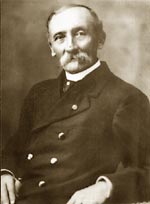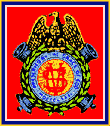by Stephen A. Michaels, Wis. Dept. Co., SUVCW
The first GAR department was officially organized at Madison, Wisconsin on June 7, 1866.
At that meeting, Gen. James K. Proudfit was elected Department Commander. within 3 months' time, eight posts had been established in the state, the first being the Cassius Fairchild Post #1, chartered at Madison on June 10, 1866 with 17 members.
The GAR made its first appearance in Milwaukee on July 31, 1866. Two independent organizations had been formed and from these were recruited Phil Sheridan Post, No. 3, which was chartered on the above date. On September 16, 1875, General John Sedgwick Post, No. 12, was chartered and held its meetings at the National Home (now on the VA grounds).
It was disbanded within a short time after its organization and many of its members joined Veteran Post, No. 8, which had at the Home one of the finest post rooms in the state.
Interest in Sheridan Post lagged and it died a natural death. Some of its members organized Robert Chivas Post, No. 2 (Robert Chivas was a nephew of the late Alexander Mitchell and a lieutenant in the 24th Wisconsin, who was killed at Missionary Ridge on November 25, 1863).
Following an initial period of enthusiasm, the GAR experienced a general decline in membership and interest not only in Wisconsin, but throughout the nation as well. GAR historians attribute the decline to the neglect of proper reports and organizational work, the use of grades or degrees of membership, participation in partisan politics, and a waning interest among some of the early members.
To its credit, the Department of Wisconsin maintained its organization and held annual encampments during the lean years of 1868 to approximately 1879.
But so ineffective had the GAR in Wisconsin become, that when the department encampment was held at Berlin, Wisconsin, in January, 1879, there were but 3 posts represented.
The most important business that came before the meeting was the proposition as to whether the Wisconsin department should surrender its charter and become part of the Illinois department. At the time, a Wisconsin Reunion Association was organized in Berlin, Wisc.
It was composed partially of Grand Army men and a large majority of ex-soldiers, who did not belong to any post. Col. Colwert K. Pier was made president and Griff J. Thomas of Berlin, secretary of the association. It was decided to hold a reunion in Milwaukee of all the Wisconsin soldiers who could be brought together, during the week of June 8, 1880. C.K. Pier composed a circular on January 11, 1879, that was published in practically all the papers in the state, and in hundreds of papers outside of the state. It concluded with this appeal:
"Comrades! Attend to this at once, or we shall not know
whether you are dead, proud or gone to Texas."
Replies poured into the secretary's office for a year and a half. Many letters contained war incidents, bits of biography and valuable war history.
Col. Pier used this information and began a series of articles, which were printed in The Milwaukee Sunday Telegraph until the time of the reunion. These articles laid the foundation for the agitation which brought not only the greatest soldier reunion ever held, but also was the beginning of a new growth of the Grand Army of the Republic.
Fully a quarter of a million people, including 100 thousand ex-soldiers, gathered in Milwaukee. All of what was known as Prospect Hill was covered with tents. Hotels and private homes were filled to overflowing. The city raised $40,000 for the entertainment of its guests during the week of the reunion.
Generals U.S. Grant and Phil Sheridan arrived by special train and were guests of honor at the campfire and parade. Wisconsin's famed war eagle, "Old Abe," was there for what would be his last parade. The doubling of the city's population and trebling of her industries within the next 12 years is often attributed to the impetus given by the reunion.
Most of the GAR posts in Wisconsin were organized in the decade between 1880 and 1890. The Wisconsin Department was one of several that experienced growing pains. During the administration of Commander Griff J. Thomas (1879-81), Post No. 1 at Madison refused to cooperate with the Department to the extent of ignoring letters written to it. After consultation with the Commander-in-Chief, Thomas annulled its charter. E.B. Wolcott Post was chartered January 5, 1880 in Milwaukee and was awarded the coveted designation of No. 1. That post was on the point of surrendering its charter in 1881, but finally determined not to surrender and steadily improved to the point of having the largest membership in the state. Other Grand Army Posts in the city were the Robert Mueller #250, the Rank and File #240, the George C. Drake #223, and William Steinmeyer #274. Women's Relief Corps were connected with most of the Milwaukee Grand Army posts and there were several Circles of the Ladies of the GAR. A Wisconsin law requiring the display of the U.S. flag over every schoolhouse in the state had its origins at a soldiers gathering at Plymouth, Wisconsin in June 1884.
Gen. Harrison C. Hobart of the Wolcott Post made the following address: "I hope to live to see that flag displayed in or over every educational institution throughout the nation, from the little district school in the back town to the great university, and if perchance churches adopt the custom of so placing it, where all who worship may see it, all the better.,' Milwaukee hosted the National GAR Encampments of 1889, 1923, and 1943. At the 1889 Encampment, Gen. William T. Sherman made his last visit to the city, and reviewed the great parade of veterans. One of the attractions of the week was a naval battle planned and conducted by Cpt. J.B. Oliver, captain of Battery A. The revenue cutters "Michigan" and "Andy Johnson" participated. The shore force, consisting of the Wisconsin National Guard, extended from the Northwestern railroad depot to the government pier. Milwaukee's E.B. Wolcott Post #1 furnished two GAR Commanders-in-Chief: August G. Weissert in 1892 and Frank A. Walsh in 1926. Comrade George W. Peck served as Milwaukee's mayor and was one of eight Post Civil War governors of Wisconsin. Time eventually began decimating the ranks of the Grand Army. Post 1 membership, once numbering 600, dropped to 195 members by January lst, 1915. Five years later, it was the only post listed in the Milwaukee City Directory and one of 3 with more than 50 members. By 1941, William P. Bryant, age 93, was one of 2 surviving Civil War vets in Milwaukee and the only active member of the Wolcott Post. He conducted post meetings at the Milwaukee County Library each Saturday with the help of the Sons of Union Veterans. A decade later, on September 29, 1951, the last Civil War survivor to live in Wisconsin, 105 year old Lansing A. Wilcox, died at the Grand Army Home at King. As a patriotic order, the GAR not only urged display of the U.S. flag over schoolhouses, it conducted a history text book campaign after the issue was presented at the department encampment in 1887. Three years later, when theCommander-in-Chief instructed posts to urge patriotism in schools, Wisconsin posts sponsored a series of free lectures on Civil War subjects in our schools. In 1898, Milwaukee GAR members, along with others in Wisconsin,helped enlist 2,000 men to fight in the Spanish American War. As a charitable and fraternal order, Wisconsin's GAR urged the founding of a Soldiers' Home in King, Wisconsin. Milwaukee posts did their part in helping raise over $5,000 toward establishing that facility in 1897. On September 15, 1934, after 18 years and a World War, Milwaukee's Abraham Lincoln memorial was dedicated. Prior to World War I,, E.B. Wolcott Post and members of the business community raised $5,000 for the project. The statue, which was to commemorate Lincoln's visit to Milwaukee in 1859, now stands near its original site near the War Memorial Center, on Lincoln Memorial Drive ... "an expression of love, loyalty of country and reverence for a great emancipator-"
Sons of Union Veterans of the Civil War Department of Wisconsin
Comments to Dept. Signals Officer
Last Updated:
|

